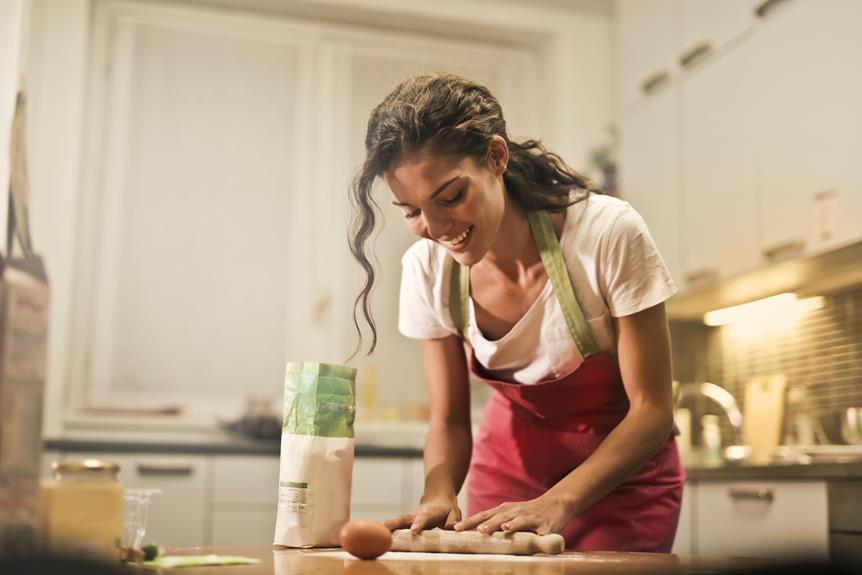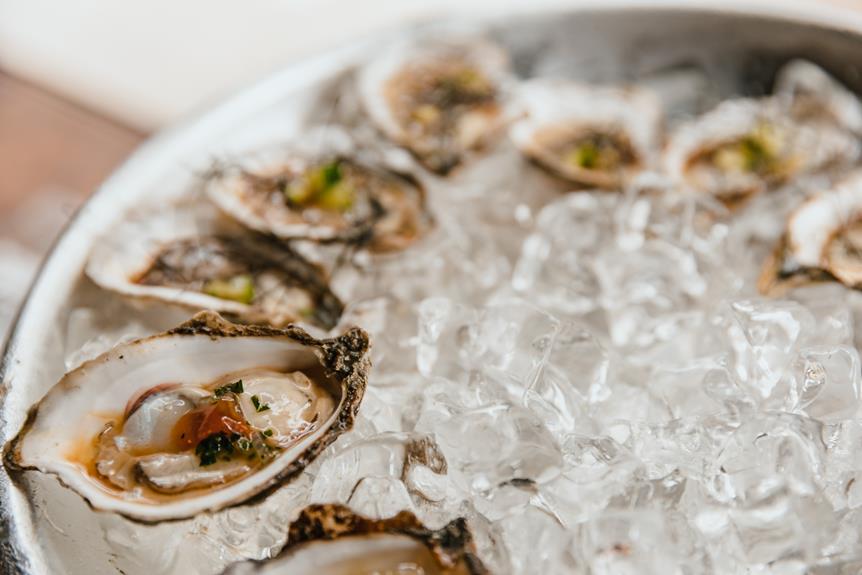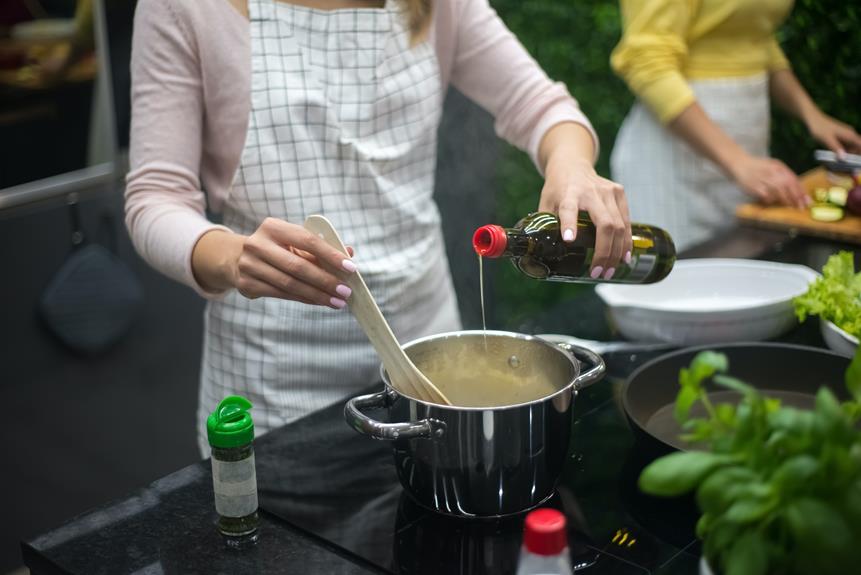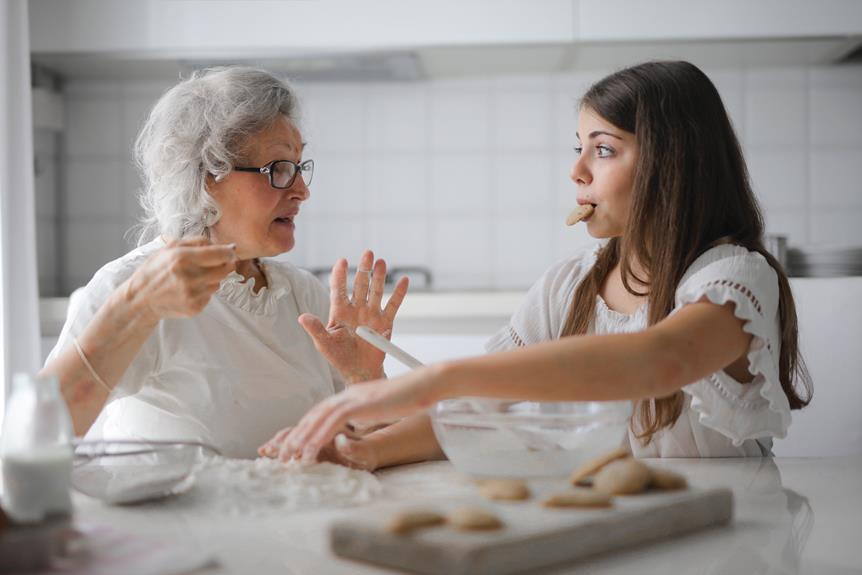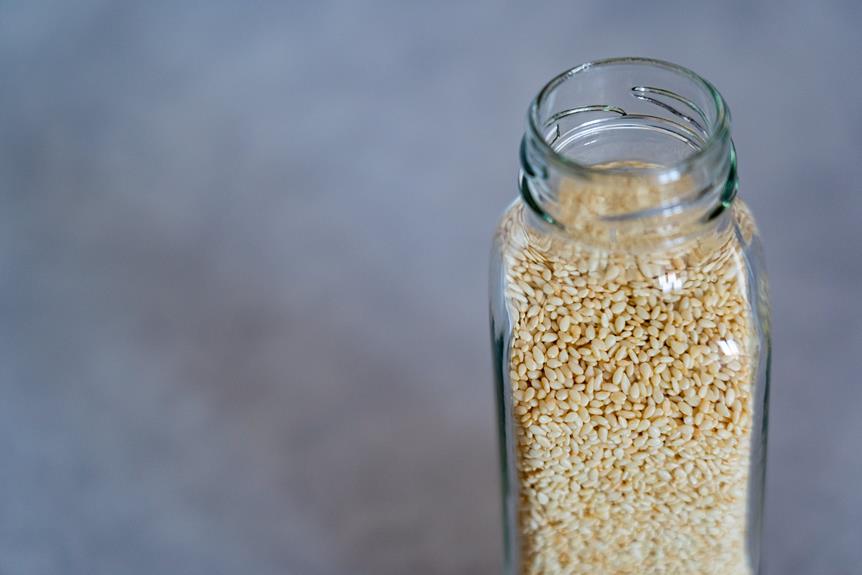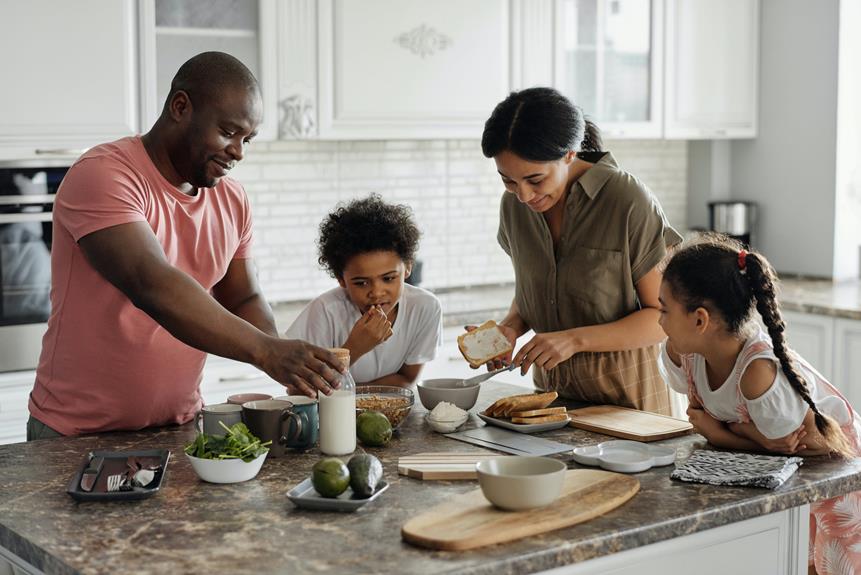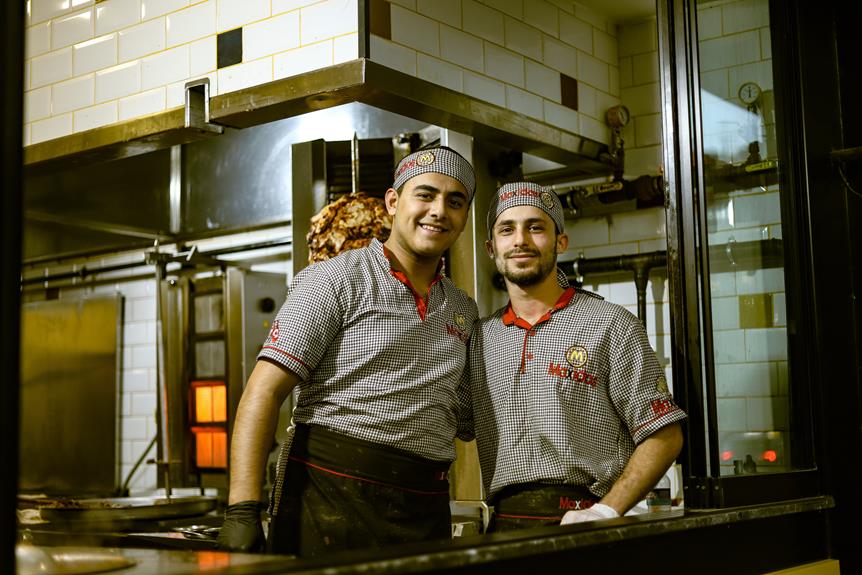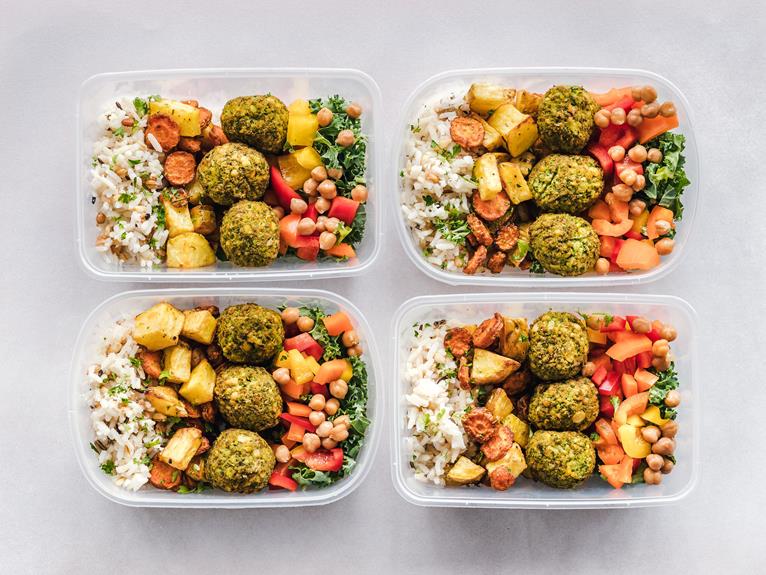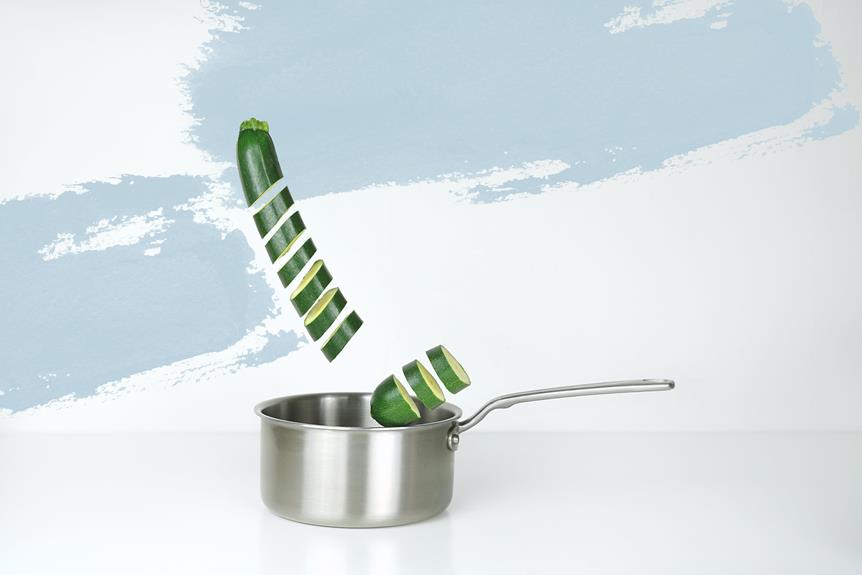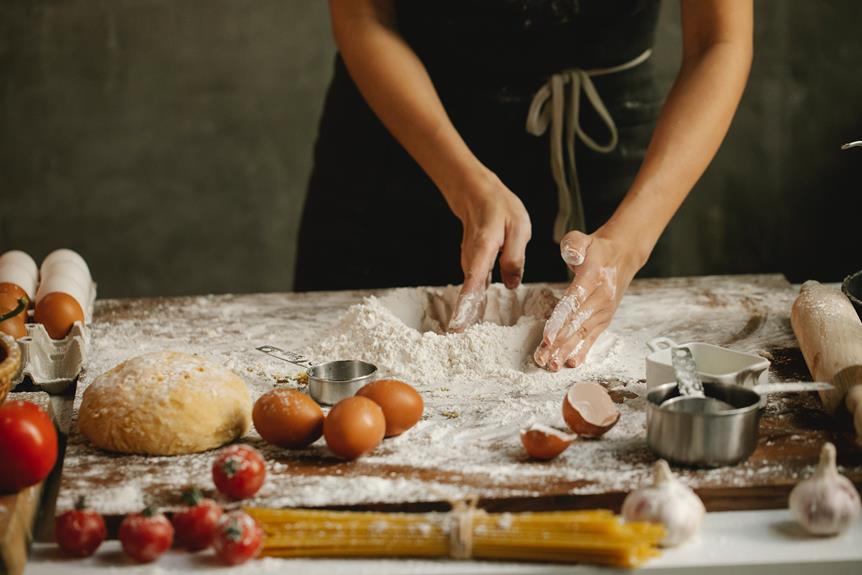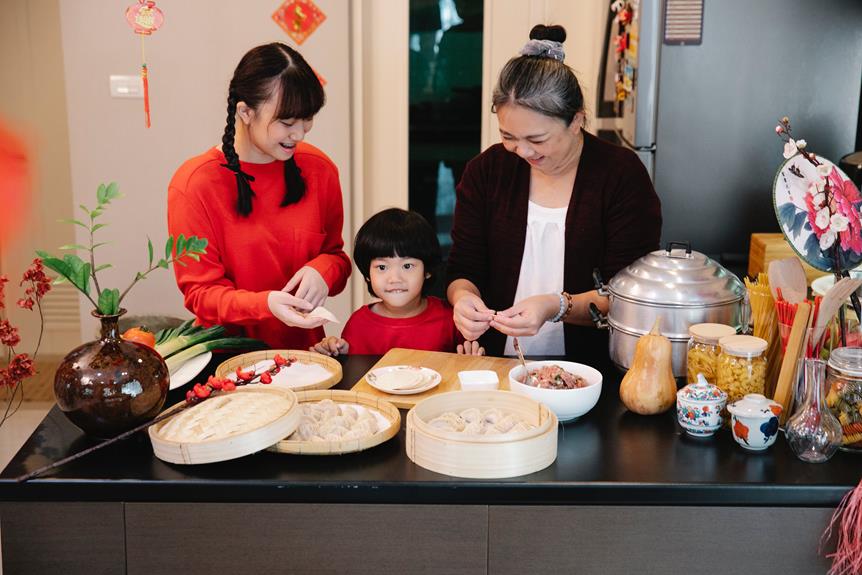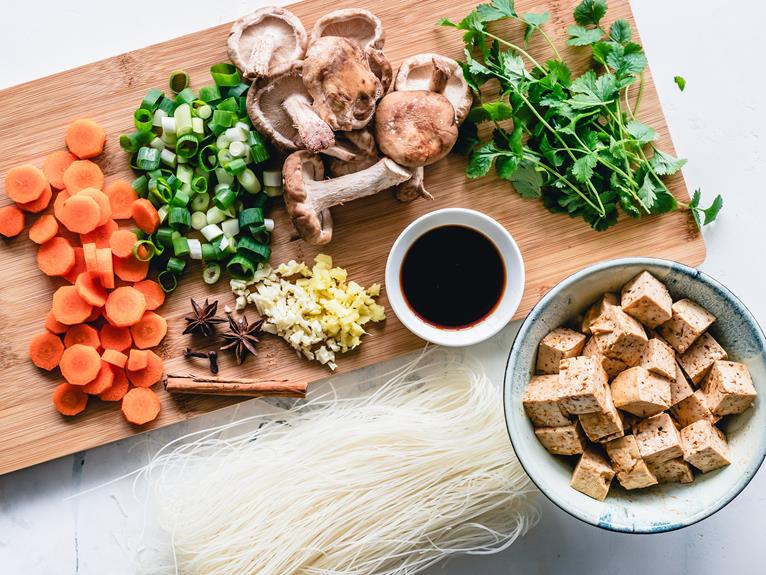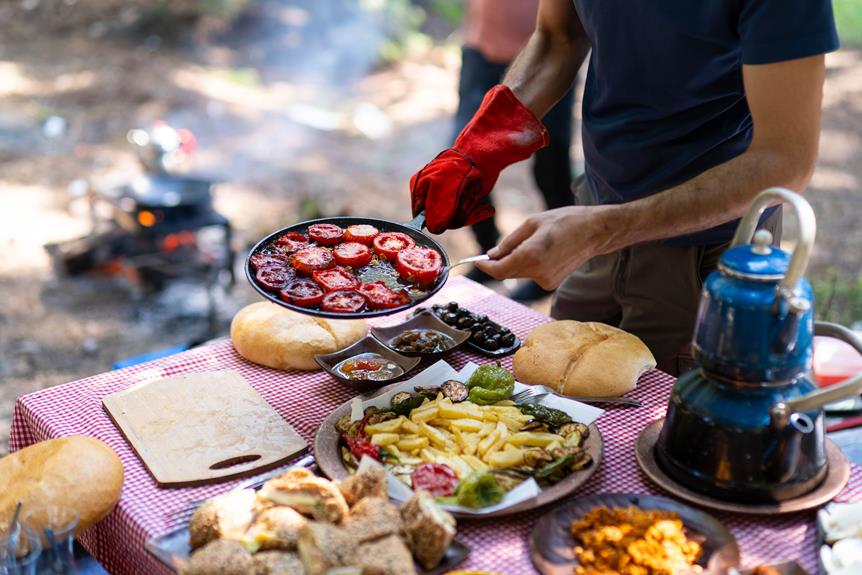Did you know that there are many cooking techniques that can elevate your homemade meals? From sautéing to grilling, each method adds its own unique flavor and texture.
But with so many options, where should you start? Let's explore 14 tried and true cooking techniques that will enhance your culinary skills and leave your taste buds wanting more.
Get ready for a culinary adventure as we uncover the secrets to creating delicious homemade meals that will impress even the most discerning palates.
Roasting
To achieve a perfectly browned and flavorful dish, roast your ingredients in the oven using high heat. Roasting is a versatile cooking technique that adds depth and richness to a wide variety of ingredients. Different roasting temperatures can be used depending on the specific dish you're preparing.
For meats and poultry, a higher temperature of around 400 to 450 degrees Fahrenheit is recommended to achieve a crispy exterior and juicy interior. Vegetables, on the other hand, are best roasted at a slightly lower temperature of 375 to 400 degrees Fahrenheit to ensure even cooking and caramelization.
Proper roasting times and techniques are essential to ensure that your dish turns out perfectly. It's important to preheat the oven before roasting to ensure even cooking. For meats, use a meat thermometer to determine the internal temperature and cook until it reaches the desired level of doneness. This can vary depending on the type and size of the meat.
Vegetables should be roasted until they're tender and slightly browned, usually around 20 to 30 minutes.
Grilling
Grilling is a fantastic way to infuse your food with a smoky flavor and achieve a delicious char on the outside. To grill juicy steaks to perfection, there are a few techniques you can follow.
Start by preheating your grill to high heat. This ensures a nice sear and locks in all the juicy flavors. Before placing the steak on the grill, generously season it with salt and pepper.
Cook the steak for about 4-6 minutes per side for a medium-rare doneness. Remember to let the steak rest for a few minutes before slicing to allow the juices to redistribute.
Now, let's talk about grilling vegetables. Choose firm vegetables with a high water content, like bell peppers, zucchini, and eggplant. Preheat your grill to medium heat and brush the vegetables with olive oil to prevent sticking.
Place them directly on the grill grates and cook for about 4-6 minutes per side, until they're tender and have nice grill marks. To enhance the flavor, you can also season the vegetables with your favorite herbs or spices.
Grilling is a simple and enjoyable way to prepare delicious meals. By following these tips, you'll be able to create mouthwatering steaks and perfectly grilled vegetables. So fire up your grill and get ready to enjoy a fantastic outdoor cooking experience!
Sauteing
If you want a versatile cooking technique, sautéing is a great option. It allows you to quickly cook ingredients while preserving their natural flavors. Sauteing involves cooking food in a small amount of oil or fat over high heat. It's perfect for when you want a quick and delicious meal, whether it's for a weeknight dinner or a special occasion.
To perfect the sauté, start by prepping your ingredients. Make sure they're cut into uniform sizes for even cooking. Heat your pan over medium-high heat and add a small amount of oil or butter. Once the oil is hot and shimmering, add your ingredients to the pan. Keep the heat high and constantly move the ingredients to prevent sticking and promote even browning.
The key to a successful sauté is to avoid overcrowding the pan. Cook in batches if necessary, as overcrowding can lead to steaming instead of browning. Use a wide pan or skillet to provide enough space for the ingredients to spread out. This helps achieve desirable caramelization and crispness.
Remember to season your ingredients with salt, pepper, or your choice of spices to enhance their flavors. You can also add aromatics like garlic or onions to infuse extra taste into your dish. And don't forget to deglaze the pan with a splash of liquid like wine, broth, or lemon juice to create a flavorful sauce.
Sautéing is a versatile cooking technique that allows you to create delicious meals with ease. By following these tips and perfecting the sauté, you'll be able to enjoy flavorful and mouthwatering dishes every time.
Braising
Braising is a slow cooking technique that tenderizes meat and adds delicious flavors. It's a cozy and comforting method that brings warmth to your kitchen. The benefits of braising are plentiful.
First, it turns tough cuts of meat into tender and juicy goodness. The slow cooking process breaks down the tough tissues, resulting in melt-in-your-mouth meat.
Second, braising infuses the meat with deep and complex flavors. As the meat simmers in a flavorful liquid, it absorbs all the deliciousness, creating a mouthwatering dish.
When choosing cuts of meat for braising, opt for those with more connective tissue. Cuts like beef chuck, pork shoulder, and lamb shanks benefit from the slow cooking process. The connective tissues break down and turn into gelatin, resulting in a luscious and velvety texture.
But braising isn't limited to meat. You can also braise vegetables to bring out their natural sweetness and enhance their flavors. Sturdy vegetables like carrots, onions, and cabbage work well for braising. Cut them into even pieces for consistent cooking. Add a flavorful liquid such as broth or wine, and let them simmer until they become tender and delicious.
Incorporating the technique of braising into your cooking repertoire will elevate your meals and make you feel like a skilled chef. So gather your ingredients, embrace the slow cooking process, and savor the delicious results.
Steaming
To make your cooking healthier, try steaming your ingredients for a light and delicious meal. Steaming is a cooking method that uses steam to cook food, preserving its natural flavors and nutrients.
Steaming is a great choice for healthy cooking because it requires little to no oil, making it a low-fat option. It also helps retain the vitamins and minerals in your food, as the steam doesn't wash them away like water can. Additionally, steaming keeps the natural colors and textures of the ingredients intact, resulting in visually appealing dishes.
There are different ways to steam your food. One popular method is using a steamer basket, which allows you to steam multiple ingredients at once. Another option is a bamboo steamer, commonly used in Asian cuisine. You can also use a stovetop or electric steamer, depending on your preference and available equipment.
Steaming your ingredients is a simple and healthy cooking technique that can elevate your meals. Give it a try and experience the light and flavorful benefits it brings to your dishes.
Stir-frying
Let's now talk about stir-frying, a quick and delicious cooking method that adds a flavorful twist to your healthy meals. Stir-frying involves cooking small pieces of food in a hot pan with a little oil. It originated in China and has gained popularity worldwide for its ability to preserve the natural flavors and textures of the ingredients.
There are several advantages to stir-frying. Firstly, it helps retain the nutrients of the ingredients due to the short cooking time. Secondly, it allows for a variety of vegetables and proteins to be used, making it a versatile option for creating different dishes. Lastly, stir-frying creates visually appealing, vibrant, and colorful meals that enhance the overall dining experience.
However, there are a few things to consider. Stir-frying requires high heat, which can be challenging to control, and there's a risk of overcooking the ingredients. Additionally, it requires constant attention and quick movements to ensure even cooking.
Now, let's compare stir-frying with sautéing to understand the key differences:
- Stir-frying: High heat and quick cooking, using bite-sized ingredients, constant stirring and flipping.
- Sautéing: Lower heat and slower cooking, using larger ingredients, and occasional stirring.
Baking
Baking is a versatile cooking technique that uses dry heat in an oven to turn ingredients into delicious and golden-brown dishes. If you want to perfect your pastries and bread, here are some baking tips and tricks that will impress your loved ones.
First, always preheat your oven to ensure even cooking and proper browning. For pastries, it's important to keep your ingredients cold to achieve a flaky texture. Use chilled butter and cold water when making pie crusts or croissants.
When baking bread, kneading the dough properly is essential. Knead it until it becomes smooth and elastic to develop the gluten. Another important tip is to use the right kind of flour. Bread flour is ideal for bread because it has a higher protein content, resulting in a chewier texture.
When exploring different baking techniques for sweet and savory dishes, don't be afraid to experiment with flavors. Add spices like cinnamon or nutmeg to your sweet treats for an extra kick. For savory dishes, try incorporating herbs like rosemary or thyme to enhance the flavors.
With these baking tips and tricks, you'll be able to create mouthwatering pastries and bread and explore a whole new world of delicious sweet and savory dishes.
Poaching
If you've become skilled at baking, it's time to broaden your culinary horizons and try your hand at poaching. Poaching is a gentle and versatile cooking technique that involves cooking food in a liquid, like water, broth, or wine, at a low and steady temperature. It's a great way to add delicious flavors to your dishes and achieve tender and moist results.
To make your poaching even more flavorful, you can enhance the cooking liquid by adding herbs, spices, citrus zest, or aromatics like onions and garlic. This will give your dish a depth of flavor that will make it even more enjoyable and satisfying. You can also experiment with different liquids for poaching, such as coconut milk, tomato sauce, or fruit juice, to give your recipes a unique twist.
Now, let's explore the differences between poaching and boiling. While both techniques involve cooking food in liquid, poaching is done at a lower temperature, usually around 160-180°F (71-82°C), whereas boiling is done at a higher temperature, around 212°F (100°C). Poaching is perfect for delicate foods like fish, eggs, or poultry, as it prevents them from becoming tough or overcooked. On the other hand, boiling is better suited for heartier ingredients like pasta, potatoes, or tough cuts of meat, as it allows for faster and more vigorous cooking.
Boiling
Boiling is a simple and essential cooking method. It involves submerging food in liquid and heating it until it reaches its boiling point. This technique is used to cook a variety of ingredients such as vegetables, pasta, rice, and eggs.
There are different boiling methods depending on what you're cooking. For delicate items like eggs or seafood, a gentle boil is best to avoid tough or overcooked results. For heartier ingredients like potatoes or pasta, a rolling boil is needed for even cooking and the right texture.
To achieve the perfect boil, start by using a pot that can comfortably hold your ingredients. Fill the pot with enough water to cover the food, but avoid overfilling to prevent overflowing. Enhance the flavor by adding salt or other seasonings.
Bring the water to a boil over high heat, then reduce it to a steady simmer. Keep an eye on the food, adjusting the heat as needed to prevent boiling over or sticking to the pot.
Once the food is cooked to your liking, remove it from the heat and drain it well. You can use the boiled ingredients in various recipes or enjoy them on their own.
Boiling is a versatile and straightforward cooking technique that can be mastered with practice.
Simmering
Let's talk about simmering, a cooking technique that's essential to know. Simmering involves cooking ingredients in liquid at a lower temperature than boiling, usually between 180°F to 205°F (82°C to 96°C). This gentle cooking method allows flavors to blend and develop slowly, resulting in flavorful and complex dishes.
Simmering is especially great for making soups and stews. By simmering the ingredients for a longer time, the flavors have a chance to infuse into the broth, creating deep and hearty flavors. It's important to keep the heat low and maintain a gentle simmer to avoid boiling the liquid too rapidly and becoming too hot.
Simmering is also fantastic for cooking seafood. Simmering delicate fish or shellfish in a fragrant broth or sauce enhances their natural flavors without overcooking them. The slow and gentle cooking process ensures that the seafood remains tender and moist, resulting in delicious dishes that will impress your guests.
Incorporating simmering into your cooking repertoire will elevate your meals. Whether you're making a hearty stew or a delicate seafood dish, this technique will help you achieve delicious and satisfying results every time. Embrace the warmth and depth of simmering to create dishes that will make you feel like a skilled and accomplished chef.
Broiling
Broiling is a cooking technique that uses high heat to quickly cook food. There are two main methods of broiling: direct and indirect.
With direct broiling, the food is placed directly under the broiler element. This is great for thin cuts of meat or fish, as it allows for fast and even cooking.
Indirect broiling involves placing the food on a rack or baking sheet, slightly away from the broiler element. This method is ideal for thicker cuts of meat that need more time to cook through. It ensures even cooking without burning the surface.
Broiling differs from grilling in that it's done indoors using the oven's broiler element, while grilling is done outdoors on a grill. Broiling offers a more controlled cooking environment, making it easier to achieve consistent results. Grilling, on the other hand, provides a smoky flavor from cooking over an open flame.
Both broiling and grilling can help you create delicious dishes to impress your family and friends. So whether you're using the broiler or firing up the grill, get ready to enjoy some mouthwatering homemade meals!
Blanching
Blanching is a cooking technique that can help you prepare vegetables before cooking them. It has several benefits, including preserving the vibrant color of the vegetables and retaining their nutrients.
To blanch vegetables and maintain their vibrant color, there are a few tips you should keep in mind. Use a large pot of boiling water with enough space for the vegetables to move around freely. This ensures even cooking and prevents overcrowding.
Blanch the vegetables for only a short period of time, typically around 1-2 minutes, depending on the type and size of the vegetable. Once the blanching time is up, immediately transfer the vegetables to an ice bath to stop the cooking process and preserve their color.
Marinating
Marinating is a technique that can greatly enhance the flavor and tenderness of your meat or vegetables. It involves soaking your food in a flavorful mixture to allow the flavors to penetrate and infuse the ingredients.
To marinate effectively, follow these guidelines:
- Choose the right marinade: Create a marinade that complements your dish by experimenting with different combinations of herbs, spices, oils, acids, and sweeteners. Popular choices for a marinade base include citrus juices, soy sauce, yogurt, and vinegar.
- Proper marinating time: The length of marinating time varies depending on the type of food. Poultry and fish usually only need 30 minutes to 2 hours. Beef and pork benefit from longer marinating times, ranging from 2 hours to overnight. Vegetables typically require 15-30 minutes of marinating to enhance their flavor.
Pan-frying
Pan-frying is a versatile cooking technique that allows you to quickly cook your food in a shallow pan with a small amount of oil or fat. It's a great way to achieve a crispy exterior while keeping the inside tender and juicy. Whether you're perfecting the art of crispy pan-fried chicken or exploring different pan-frying techniques for vegetables, this method of cooking can elevate your homemade meals to a whole new level.
To help you understand the different pan-frying techniques, here is a table highlighting three popular methods:
- Searing: Cooking at high heat to develop a brown crust. This technique is best for steaks and pork chops.
- Sauteing: Quickly cooking small, bite-sized pieces of food. It works well for shrimp and sliced vegetables.
- Breading and frying: Coating food with breadcrumbs before frying. This method is perfect for chicken tenders and fish fillets.
Conclusion
Now that you've learned various cooking techniques for delicious homemade meals, you can improve your culinary skills.
Did you know that incorporating these techniques into your cooking can significantly enhance the taste and flavor?
By mastering these methods, you'll be able to create mouthwatering dishes that will impress your loved ones.
So, put on your apron and get ready to unleash your inner chef!

